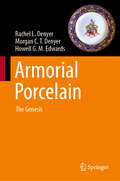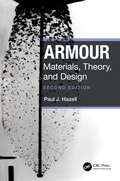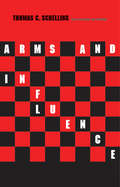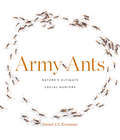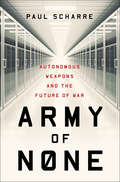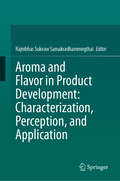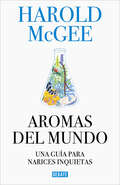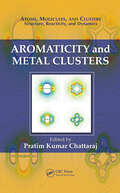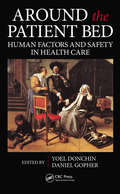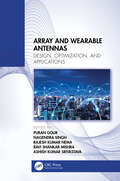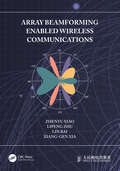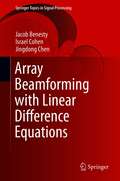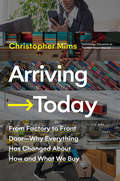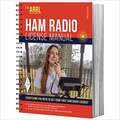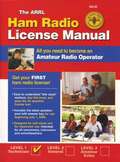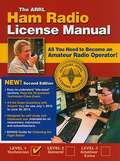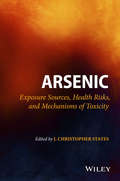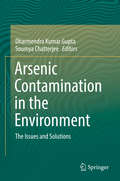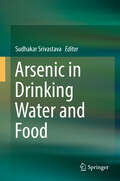- Table View
- List View
Armorial Porcelain: The Genesis
by Howell G. Edwards Rachel L. Denyer Morgan C.T. DenyerThis book explores the genesis of armorial porcelain manufacture in Britain. While heraldic devices began appearing on Chinese porcelain from the sixteenth century onwards, armorials did not appear on British porcelain until the 1750s. It examines the development of porcelain in China and traces its introduction to Western Europe. The book delves into the market for armorial porcelains, from the early commissioning of Chinese armorial porcelainware to the establishment of manufactories in England capable of producing armorial porcelain. It also discusses the reasons behind the timing of armorial porcelain's manufacture in Britain. Additionally, it assesses armorial porcelain as a contemporary historical source. Building upon previous research by the authors, the book presents armorial porcelain as a distinct and highly personalized product. By integrating detailed genealogical research, cultural insights, and chemical analysis, it offers a comprehensive understanding of armorial porcelain within the context of heritage, culture, and science.
Armour: Materials, Theory, and Design
by Paul J. HazellUpdated throughout for the new edition, Armour: Materials, Theory, and Design covers extant and emergent protection technologies driving advances in armour systems. Covering materials, theory and design, the book has applications in vehicle, ship, personnel and building use.Introducing a wide range of armour technologies, the book is a key guide to the technology used to protect against both blasts and ballistic attacks. Chapters cover bullets, blasts, jets and fragments, as well as penetration mechanics. The new edition builds on the previous one, discussing ceramics and metallic materials as well as woven fabrics and composite laminates. Detailing modern technology advancements, the second edition has also been expanded to include improved explanations on shock mechanisms and includes significantly more figures and diagrams.An essential guide to armour technology, this book outlines key ways to implement protective strategies applicable for many types of conflict.
Armoured Cruiser Cressy: Detailed in the Original Builders' Plans
by Andrew ChoongThe complete set of builders’ plans for the Royal Navy’s Victorian era armored cruiser famously sunk during WWI.The builders of British warships created a highly detailed set of plans for each ship upon completion. These highly detailed, multicolored drawings represented the exact appearance and specifications of the ship as it entered service. Today, the National Maritime Museum and Seaforth Publishing are making these invaluable resources available to the public through a series of books featuring high-quality digital reproductions.This volume presents the plans for the armored cruiser HMS Cressy. Launched on December 4th, 1899, it best known for the disaster of September 22nd, 1914, in which Cressy and two sister-ships were sunk by a small submarine. Though obsolete by the First World War, Cressy-class cruisers were innovative ships in their day.In full color, with many close-ups and enlargements, these plans make every aspect of the HMS Cressy clear and comprehensible. Extensive captions point the reader to important features to be found in the plans, and an introduction covers the design’s background.
Arms and Influence
by Prof. Thomas C. SchellingThe author concentrates in this book n the way in which military capabilities real or imagined are used, skillfully of clumsily, as bargaining power. He sees the steps taken by the U. S. during the Berlin and Cuban crises as not merely preparations for engagement, but as signals to and enemy, with reports from the adversary's own military intelligence as our most important diplomatic communications.
Arms and Influence (Veritas Paperbacks)
by Thomas C. Schelling&“This is a brilliant and hardheaded book. It will frighten those who prefer not to dwell on the unthinkable and infuriate those who have taken refuge in stereotypes and moral attitudinizing.&”—Gordon A. Craig, New York Times Book Review Originally published more than fifty years ago, this landmark book explores the ways in which military capabilities—real or imagined—are used, skillfully or clumsily, as bargaining power. Anne-Marie Slaughter&’s new introduction to the work shows how Schelling&’s framework—conceived of in a time of superpowers and mutually assured destruction—still applies to our multipolar world, where wars are fought as much online as on the ground.
Arms Production In Japan: The Military Applications Of Civilian Technology
by Reinhard DrifteAlthough Japan's arms industry is still relatively small, significant political, economic, and technological developments indicate its growing importance and pave the way for Japan's increasing involvement in arms production. In this comprehensive study, Dr. Drifte examines both the domestic and international environments that are encouraging Japan
Army Ants: Nature's Ultimate Social Hunters
by Daniel J. KronauerA richly illustrated, captivating study of army ants, nature’s preeminent social hunters.A swarm raid is one of nature’s great spectacles. In tropical rainforests around the world, army ants march in groups by the thousands to overwhelm large solitary invertebrates, along with nests of termites, wasps, and other ants. They kill and dismember their prey and carry it back to their nest, where their hungry brood devours it. They are the ultimate social hunters, demonstrating the most fascinating collective behavior.In Army Ants we see how these insects play a crucial role in promoting and sustaining the biodiversity of tropical ecosystems. The ants help keep prey communities in check while also providing nutrition for other animals. Many species depend on army ants for survival, including a multitude of social parasites, swarm-following birds, and flies. And while their hunting behavior, and the rules that govern it, are clearly impressive, army ants display collective behavior in other ways that are no less dazzling. They build living nests, called bivouacs, using their bodies to protect the queen and larvae. The ants can even construct bridges over open space or obstacles by linking to one another using their feet. These incredible feats happen without central coordination. They are the result of local interactions—self-organization that benefits the society at large.Through observations, stories, and stunning images, Daniel Kronauer brings these fascinating creatures to life. Army ants may be small, but their collective intelligence and impact on their environment are anything but.
Army of None: Autonomous Weapons And The Future Of War
by Paul ScharreA Pentagon defense expert and former U.S. Army Ranger explores what it would mean to give machines authority over the ultimate decision of life or death. <P><P> What happens when a Predator drone has as much autonomy as a Google car? Or when a weapon that can hunt its own targets is hacked? Although it sounds like science fiction, the technology already exists to create weapons that can attack targets without human input. Paul Scharre, a leading expert in emerging weapons technologies, draws on deep research and firsthand experience to explore how these next-generation weapons are changing warfare. <P><P> Scharre’s far-ranging investigation examines the emergence of autonomous weapons, the movement to ban them, and the legal and ethical issues surrounding their use. He spotlights artificial intelligence in military technology, spanning decades of innovation from German noise-seeking Wren torpedoes in World War II—antecedents of today’s homing missiles—to autonomous cyber weapons, submarine-hunting robot ships, and robot tank armies. Through interviews with defense experts, ethicists, psychologists, and activists, Scharre surveys what challenges might face "centaur warfighters" on future battlefields, which will combine human and machine cognition. We’ve made tremendous technological progress in the past few decades, but we have also glimpsed the terrifying mishaps that can result from complex automated systems—such as when advanced F-22 fighter jets experienced a computer meltdown the first time they flew over the International Date Line. <P><P>At least thirty countries already have defensive autonomous weapons that operate under human supervision. Around the globe, militaries are racing to build robotic weapons with increasing autonomy. The ethical questions within this book grow more pressing each day. To what extent should such technologies be advanced? And if responsible democracies ban them, would that stop rogue regimes from taking advantage? At the forefront of a game-changing debate, Army of None engages military history, global policy, and cutting-edge science to argue that we must embrace technology where it can make war more precise and humane, but without surrendering human judgment. When the choice is life or death, there is no replacement for the human heart.
Army Science And Technology For Homeland Security: Report 2
by Committee on Army Science Technology for Homeland Defense--C4ISRShortly after the events of September 11, 2001, the U.S. Army asked the National Research Council (NRC) for a series of reports on how science and technology could assist the Army meet its Homeland defense obligations. The first report, Science and Technology for Army Homeland Security—Report 1, presented a survey of a road range of technologies and recommended applying Future Force technologies to homeland security wherever possible. In particular, the report noted that the Army should play a major role in providing emergency command, control, communications, computers, intelligence, surveillance, and reconnaissance (C4ISR) capabilities and that the technology and architecture needed for homeland security C4ISR was compatible with that of the Army’s Future Force. This second report focuses on C4ISR and how it can facilitate the Army’s efforts to assist the Department of Homeland Security (DHS) and emergency responders meet a catastrophic event.
Aroma and Flavor in Product Development: Characterization, Perception, and Application
by Rajnibhas Sukeaw SamakradhamrongthaiOne of the greatest challenges facing food product developers today is that of preserving aroma and flavor stability over time without comprising quality. With Aroma and Flavor in Product Development: Characterization, Perception, and Application, researchers and product innovators will find a thorough elucidation of the dynamic interplay of aroma and flavor in complex formulations across various applications, and of the crucial role of foundational elements in crafting globally appealing products. This guide provides essential insights into perception, formation, and development, enabling developers to enhance food items' organoleptic qualities and thereby provide consumers with an enhanced sensory experience. It is unique in its focus on raw material properties, processing changes, and flavor application tools, offering comprehensive coverage of encapsulation methods, isolation, extraction, and release mechanisms. Employing tools such as gas chromatography and descriptive sensory analysis, the text decodes complex chemical compositions to enable effective communication and replication of desired sensory experiences. Readers will finish this text not only with a strong grasp on the latest insights into aroma and flavor research trends, such as sustainable sourcing and novel extraction methods, but also with a vision for the future of food product development.
Aromas del mundo: Una guía para narices inquietas
by Harold McGeeUn viaje al misterioso mundo de los olores con Harold McGee, autor de La cocina y los alimentos. En esta obra de asombrosa sabiduría y originalidad, Harold McGee destila la ciencia que hay detrás de los olores hasta obtener una guía accesible y muy entretenida sobre los aromas del mundo. Aunando vivencias personales y una rigurosa investigación, incorpora los últimos descubrimientos de la biología y la química, y revela cómo nuestro olfato, un sentido con una poderosa pero ignorada influencia en nuestra vida cotidiana, tiene el poder de exponer detalles invisibles e intangibles del mundo material, y provocar sensaciones extraordinarias. Remontándose a los orígenes de los olores en el espacio interestelar, McGee nos cuenta la fascinante historia de las moléculas que desencadenan nuestras percepciones a diario, responsables de fragancias como los aromas cítricos a cilantro y cerveza y los olores medicinalesa narcisos y erizos de mar, muchas de las cuales existían antes de que ninguna criatura pudiera olerlas. Este libro nos lleva en una aventura sensorial en la que olisquearemos lo ordinario (calle mojada y hierba cortada) y lo apetitoso (pan fresco y chocolate), lo delicioso (rosas y vainilla) y lo desagradable (carne en mal estado y huevos podridos), desde la sulfurosa tierra naciente hace más de cuatro mil millones de años hasta las tenues notas de fenol y formaldehído de nuestros teclados de ordenador. McGee rastrea olores de alimentos, bosques, ríos y flores, y nos muestra con su habitual maestría cómo aprender a detectarlos, identificarlos, valorarlos y combinarlos para transformar nuestra relación con la cocina y los sabores. La crítica ha dicho...«Una guía profundamente investigada de los olores del mundo, que capta hasta sus más volátiles moléculas.»The New York Times «Cada página está repleta del equivalente olfativo de las onomatopeyas. No decepcionará a ningún admirador de los ensayos culinarios de McGee.»The Wall Street Journal «El libro de referencia que hará que todo lo que comas parezca más interesante. Hay fascinación y deleite en cada página».The Sunday Times
Aromaticity and Metal Clusters (Atoms, Molecules, and Clusters)
by Pratim Kumar ChattarajMetal clusters, an intermediate state between molecules and the extended solid, show peculiar bonding and reactivity patterns. Their significance is critical to many areas, including air pollution, interstellar matter, clay minerals, photography, catalysis, quantum dots, and virus crystals. In Aromaticity and Metal Clusters, dozens of international
Around the Patient Bed: Human Factors and Safety in Health Care (Human Factors and Ergonomics)
by Yoel Donchin Daniel GopherThe occurrence of failures and mistakes in health care, from primary care procedures to the complexities of the operating room, has become a hot-button issue with the general public and within the medical community. Around the Patient Bed: Human Factors and Safety in Health Care examines the problem and investigates the tools to improve health care
Array and Wearable Antennas: Design, Optimization, and Applications
by Puran Gour Nagendra Singh Rajesh Kumar Nema Ravi Shankar Mishra Ashish Kumar SrivastavaThe text highlights the designing of efficient, wearable, and textile antennas for medical and wireless applications. It further discusses antenna design for the Internet of Things, biomedical, and 5G applications. The book presents machine learning and deep learning techniques for antenna design and analysis. It also covers radio frequency, micro-electromechanical systems, and nanoelectromechanical systems devices for smart antenna design.This book: Explores wearable reconfigurable antennas for wireless communication and provide the latest technique in term of its structure, defective ground plane, and fractal design Focuses on current and future technologies related to antenna design, and channel characterization for different communication links, and applications Discusses machine learning techniques for antenna design and analysis Demonstrates how nano patch antenna resonates at multiple frequencies by varying the chemical potential Covers the latest antenna technology for microwave sensors, and for fiber optical sensor communications It is primarily for senior undergraduate, graduate students, and academic researchers in the fields of electrical engineering, electronics and communications engineering.
Array Beamforming Enabled Wireless Communications
by Zhenyu Xiao Lipeng Zhu Lin Bai Xiang-Gen XiaThis book investigates the most advanced theories and methodologies of array beamforming, with a focus on antenna array enabled wireless communication technology. Combining with the current development needs and trends of wireless communication technology around the world, the authors explore the potentials and challenges of large-scale antenna array beamforming technology in next-generation mobile communication and some important emerging application scenarios. The book first introduces the basic structure of antenna array hierarchical codebook and channel estimation with high dimensionality, with which the time cost of searching the channel information can be effectively reduced. It then explicates high-efficiency beamforming transmission methods for point-to-point transmission, full-duplex point-to-point transmission, and point-to-multipoint transmission where array beamforming enabled non-orthogonal multiple access (NOMA) technologies for typical two-user systems and general multi-user systems are emphasized. The book also discusses array beamforming enabled unmanned aerial vehicle (UAV) communications and array beamforming enabled space/air/ground communications, with the uniqueness and relative solutions for single UAV systems and multi-UAV networks being analyzed. This will be a vital reference for researchers, students, and professionals interested in wireless communications, array beamforming, and millimeter-wave communications.
Array Beamforming with Linear Difference Equations (Springer Topics in Signal Processing #20)
by Jacob Benesty Israel Cohen Jingdong ChenThis book studies the link between differential beamforming and differential equations which in turn enables the study of fundamental theory and methods of beamforming from a different perspective, leading to new insights into the problem and new methods to solve the problem. The book first presents a brief overview of the problems and methods for beamforming and some performance measures popularly used either to evaluate beamformers or to derive optimal beamformers. Then, first-order, second-order, and general high-order linear difference equations are discussed, based on which the authors show how to formulate the beamforming problem and derive different beamforming methods, including fixed and adaptive ones. Furthermore, the authors show how to apply the theory of difference equations to the general problem of speech enhancement, and deduce a number of noise reduction filters, including the maximum SNR filter, the Wiener filter, the MVDR filter, etc. Also covered in the book are the difference equations and differential beamforming from the spectral graph perspective.Presents basic concepts, fundamental principles, and methods for beamforming from the perspective of linear difference equations;Provides formulation and methods of conventional beamforming, and first-order, second-order, and general high-order linear difference equations for beamforming;Includes the applications of linear difference equations to the problem of noise reduction;Explains beamforming based on difference equations with graphs.
Arriving Today: From Factory to Front Door -- Why Everything Has Changed About How and What We Buy
by Christopher MimsThe Wall Street Journal technology columnist reveals the fascinating story behind the misleadingly simple phrase shoppers take for granted—“Arriving Today”—in this eye-opening investigation into the new rules of online commerce, transportation, and supply chain management.We are at a tipping point in retail history. While consumers are profiting from the convenience of instant gratification, rapidly advancing technologies are transforming the way goods are transported and displacing workers in ways never before seen.In Arriving Today, Christopher Mims goes deep, far, and wide to uncover how a single product, from creation to delivery, weaves its way from a factory on the other side of the world to our doorstep. He analyzes the evolving technologies and management strategies necessary to keep the product moving to fulfill consumers’ demand for “arriving today” gratification. Mims reveals a world where the only thing moving faster than goods in an Amazon warehouse is the rate at which an entire industry is being gutted and rebuilt by innovation and mass shifts in human labor practices. He goes behind the scenes to uncover the paradoxes in this shift—into the world’s busiest port, the cabin of an 18-wheeler, and Amazon’s automated warehouses—to explore how the promise of “arriving today” is fulfilled through a balletic dance between humans and machines. The scope of such large-scale innovation and expended energy is equal parts inspiring, enlightening, and horrifying. As he offers a glimpse of our future, Mims asks us to consider the system’s vulnerability and its resilience, and who shoulders the burden, as we hurtle toward a fully automated system—and what it will mean when we are there.
The ARRL Extra Class License Manual For Ham Radio (9th edition)
by Ward Silver Mark WilsonUse this book to study for your Extra Class (Element 4) license exam. Every page presents information you will need to pass the exam and become an effective operator. You'll cover small sections at a time: Operating Practices, Rules and Regulations, Electrical Principles, Components and Building Blocks, Electronic Circuits, Radio Signals and Measurements, Radio Modes and Equipment, Antennas and Feed Lines, Topics in Radio Propagation, Safety.
The ARRL General Class License Manual
by American Radio Relay LeagueThe General Class license is the second of three US Amateur Radio licenses. To upgrade to General Class, you must already hold a Technician Class license (or have recently passed the Technician license exam). Upgrading to a General license--which conveys extensive HF privileges—only requires passing a written examination. Once you do, the entire range of operating modes and the majority of the amateur spectrum below 30 MHz become available to you. <P><P><i>Advisory: Bookshare has learned that this book offers only partial accessibility. We have kept it in the collection because it is useful for some of our members. Benetech is actively working on projects to improve accessibility issues such as these.</i>
ARRL Ham Radio License Manual
by Arrl Inc.Everything You Need to Get Your First Ham Radio License! The ARRL Ham Radio License Manual will help you discover all the excitement of ham radio. It has easy-to-understand "bite-sized" sections to help you get started. From understanding the rules and regulations to selecting your equipment, setting up your first station, and making your first contact! Plus, it's an excellent reference as you advance your interest in radio communications. Filled with all the information you need to pass the Technician class exam, including: Amateur Radio Rules and Activities Radio and Signals Fundamentals Electricity, Components, and Circuits Propagation, Antennas, and Feed Lines Amateur Radio Equipment Communicating with Other Hams Licensing Regulations Operating Regulations Electrical and Mechanical Safety ARRL's best-selling study guide features all the questions and answers, with detailed explanations, for examinations taken through June 30, 2026. Use it to study for the 35-question exam and there will be no surprises on exam day! Hams experiment with technology and electronics, serve the public through emergency communications, and enjoy talking to people across the country and around the world. Portable transceivers allow you to get on the air anywhere, from a park bench to a roving SUV, to a mountaintop, and more! With a Technician class license, any ham can contact the International Space Station, measure the reach of their signal with propagation beacons, or connect with others via satellite. The ARRL Ham Radio License Manual will help you get licensed on the air!
The ARRL Ham Radio License Manual (1st edition)
by Ward SilverThe most popular introduction to amateur radio, this guide offers a unique mix of technology, public service, convenience, and fun. All levels of ham radio operators can brush up on their skills and use the book to study for their first license exam with the latest questions pool with answer key.
The ARRL Ham Radio License Manual (2nd edition)
by Ward SilverThe ARRL Ham Radio License Manual is your ticket to joining the ranks of amateur radio operators. Use this book to discover the appeal of ham radio.
Arsenic
by J. Christopher StatesThis book illustrates the chemistry, toxicology, and health effects of arsenic using novel modeling techniques, case studies, experimental data, and future perspectives.* Covers exposure sources, health risks, and mechanisms of one of the most toxic minerals in the world* Helps readers understand potential health effects of arsenic, using population studies, mammalian and invertebrate models, and pharmacokinetic and toxicokinetic models* Discusses outcomes, epidemiology, real-life examples, and modes of action for arsenic-induced diseases, like lung cancer, diabetes, cardiovascular and pulmonary diseases, and immunotoxicity* Acts as a reference for toxicologists, environmental chemists, and risk assessors and includes up-to-date, novel modeling techniques for scientists* Includes future perspectives on special topics, like extrapolation from experimental models to human exposures, biomarkers for phenotypic anchoring, and pathology of chronic exposure
Arsenic Contamination in the Environment: The Issues and Solutions
by Dharmendra Kumar Gupta Soumya ChatterjeeThis book provides an overview to researchers, graduate, and undergraduate students, as well as academicians who are interested in arsenic. It covers human health risks and established cases of human ailments and sheds light on prospective control measures, both biological and physico-chemical. Arsenic (As) is a widely distributed element in the environment having no known useful physiological function in plants or animals. Historically, this metalloid has been known to be used widely as a poison. Effects of arsenic have come to light in the past few decades due to its increasing contamination in several parts of world, with the worst situation being in Bangladesh and West Bengal, India. The worrying issue is the ingestion of arsenic through water and food and associated health risks due to its carcinogenic and neurotoxic nature. The impact of the problem is widespread, and it has led to extensive research on finding both the causes and solutions. These attempts have allowed us to understand the various probable causes of arsenic contamination in the environment, and at the same time, have provided a number of possible solutions. It is reported that more than 200 mineral species contain As. Generally, As binds with iron and sulfur to form arsenopyrite. According to one estimate from the World Health Organization (WHO), contextual levels of As in soil ranges from 1 to 40 mg kg-1. Arsenic toxicity is related to its oxidation state which is present in the medium. As is a protoplastic toxin, due to its consequence on sulphydryl group it interferes in cell enzymes, cell respiration and in mitosis. Exposure of As may occur to humans via several industries, such as refining or smelting of metal ores, microelectronics, wood preservation, battery manufacturing, and also to those who work in power plants that burn arsenic-rich coal.
Arsenic in Drinking Water and Food
by Sudhakar SrivastavaArsenic contamination poses a major environmental problem, especially in Southeast Asian countries like Bangladesh and India. Threatening the health of millions of people due to arsenic’s toxicity and carcinogenicity, the major routes of arsenic exposure for humans are either through drinking water or crops. Rice is the crop most affected by arsenic owing to its cultivation in major arsenic contaminated areas, biogeochemical factors in the soil during rice growth, and specific features of rice that enable it take up more arsenic than other crop plants. This book addresses the problem of arsenic by pursuing a holistic approach. It presents the status quo in different parts of the world (North and South America, Europe, Asia, etc.) and provides essential information on food-related arsenic exposure risks for humans, and possible preventive and curative measures for tackling arsenic poisoning. It covers the arsenic contamination status of rice, rice-based products, other vegetables, fishes, mushrooms, and other foods, with a special focus on rice-arsenic interactions. The mechanisms of arsenic uptake, translocation and distribution in plants and grains are also explained. In closing, the book reviews a variety of prospective agronomic and biotechnological solutions to the problem of arsenic accumulation in rice grains. The book is intended for a broad audience including researchers, scientists, and readers with diverse backgrounds including agriculture, environmental science, food science, environmental management, and human health. It can also be used as an important reference guide for undergraduate and graduate students, university faculties, and environmentalists.
